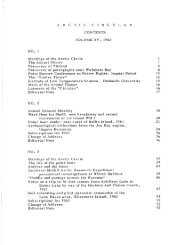Volume 11, 1958 - The Arctic Circle - Home
Volume 11, 1958 - The Arctic Circle - Home
Volume 11, 1958 - The Arctic Circle - Home
You also want an ePaper? Increase the reach of your titles
YUMPU automatically turns print PDFs into web optimized ePapers that Google loves.
VOL. XI No, 4<br />
THE ARCTIC CIRCULAR<br />
73<br />
the west coast. <strong>The</strong> limit of submergence is very clearly defined<br />
and appears to lie between 460 and 500 feet above the present sea<br />
level. In the former submerged areas the valleys draining to the<br />
west coast are filled with what appears to be terraced outwash<br />
deposits. Following a period of foggy weather we returned to<br />
Hall Beach with the dogs and sledge aboard a Dakota aircraft<br />
on July 18.<br />
We flew to Sarcpa Lake on July 24 while Kalaut returned<br />
temporarily to Igloolik to hunt walrus. Between July 24 and August 5<br />
two foot traverses, each lasting several days, were made northwest<br />
and southwest of the lake to areas which it had not been poseible to<br />
visit in 1957. We returned to Hall Beach by aircraft on August 5.<br />
Kalaut was waiting for us at Hall Beach and on August 8<br />
we travelled to Igloolik in the l6-foot aluminum boat we had used<br />
in 1957. In contrast to the previous summer we found very little<br />
drift ice alone the east coast. Brief visits were made to the<br />
Eskimo settlements at Kingmitokvik and Pinger Point. Between<br />
August 9 and 14 we visited Richards and Quilliam bays. In the<br />
vicinity of the Bouverie Islands the limit of marine submergence<br />
was found to be approximately 330 feet, considerably lower than<br />
on the west ooast and at points farther south on the east coast of<br />
the peninsula.<br />
We made a particularly interesting foot traverse<br />
across the peninsula from Mogg Bay to Franklin Bay between<br />
August 15 and 21. Travelling with the assistance of pack dogs we<br />
passed through areas of Palaeozoic sedimentary lowland, fluted<br />
till plain, and Precambrian crystalline upland to the outwashfilled<br />
valley leading to Franklin Bay. Glacial features in the area<br />
indicate that the direction of the last glacial movement was from<br />
the east-southeast toward the west-northwest. In addition,<br />
erratics of sedimentary rock which OCcur in the interior appear to<br />
be similar to the underlyinG country rock on the east side of the<br />
peninsula. <strong>The</strong>se erratics decrease in number toward the west<br />
providing additional evidence of an east to west movement. We<br />
returned to MogG Bay on August 25 and to Igloolik a day later.<br />
•<br />
I<br />
On August 27 it was necessary to return to Hall Beach<br />
to obtain mOre supplies. On the followins day the Fisheries<br />
Research Board1s vessel M.V. Calanus arrived at Hall Beach from<br />
Rowley Island, and on August 29 we returned to Igloolik aboard her.<br />
We left Igloolik by 22 -foot freighter canoe for Fury<br />
and Hecla Strait on Aucust 31. At Northeast Cape, near the eastern entranc<br />
the strait. we visited a cairn built in 1956 by personnel from












